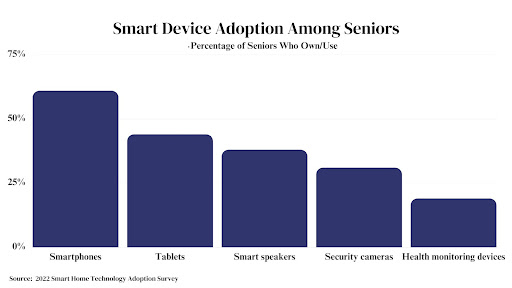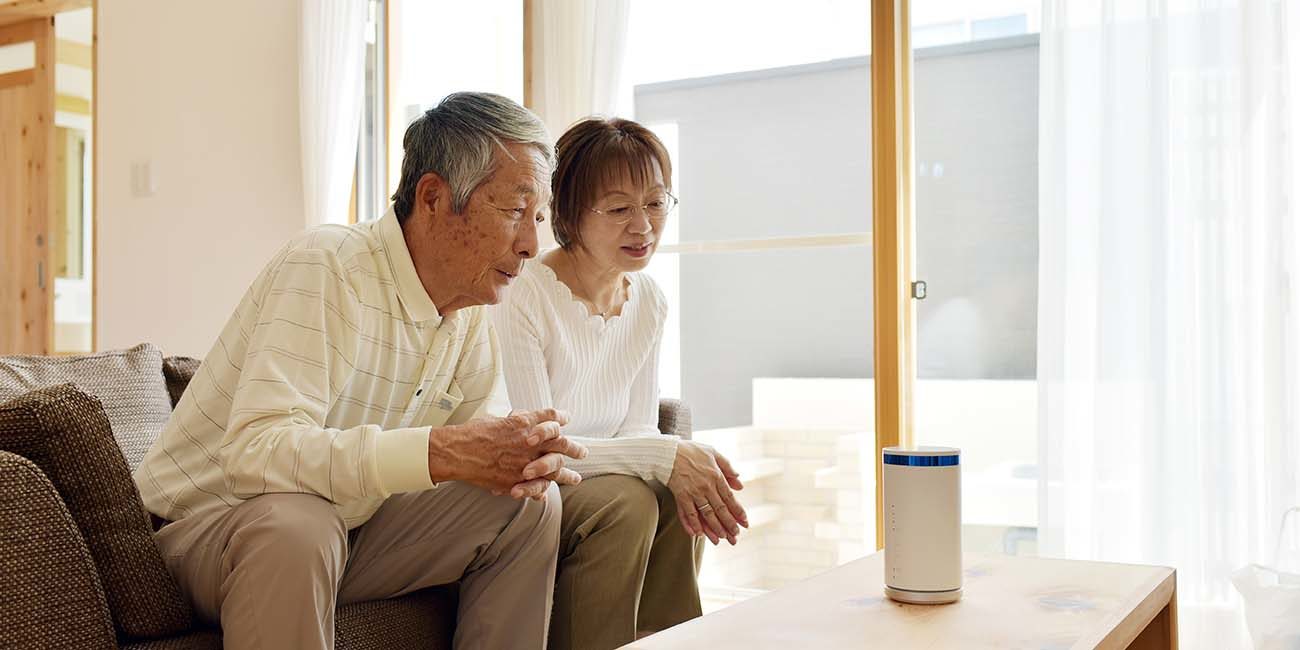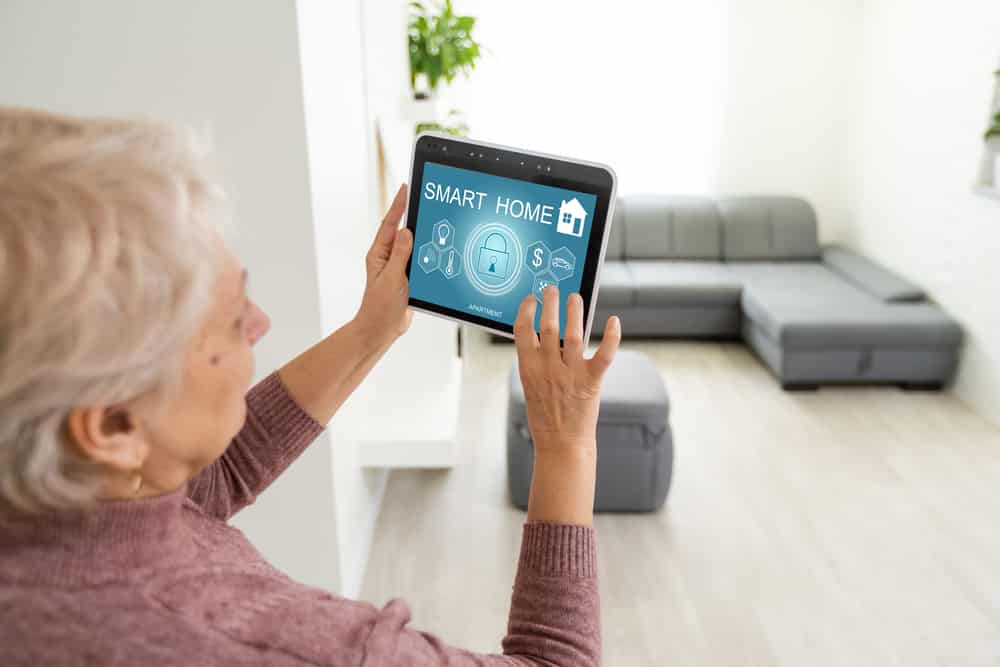The rise of smart home devices is transforming senior living and improving the quality of life for older adults. As seniors increasingly embrace technology, smart devices are enabling greater safety, health, and connectivity – pillars crucial to independent and fulfilling living.
The Growing Adoption of Technology by Seniors
Just a decade ago, few seniors interacted with technology in their daily lives. However, adoption rates have risen significantly. In 2022, 61% of adults over 65 owned a smartphone, up from only 18% in 2013 according to Pew Research Center. Tablet ownership also jumped to 44% for this demographic.
This tech-savviness is enhancing the quality of senior living. 67% of adults over 50 say technology helps them live independently. With innovative devices, seniors are able to age comfortably and securely at home rather than move to assisted living facilities preemptively.
Key Benefits of Smart Devices for the Elderly
Promoting Safety and Security
Smart home devices provide an added layer of protection, notification, and responsiveness for seniors living independently. Sensors monitor activity levels to detect irregularities like falls or inactivity which may signify an emergency. Systems can then send alerts to caregivers and family members or contact emergency services if needed.
Security cameras and video doorbells allow seniors to screen visitors remotely and only permit entry to expected guests. This provides peace of mind and reduces risks to seniors living alone.
Fostering Connection and Engagement
Isolation and loneliness are often pressing issues among the elderly. Smart devices help seniors stay connected to loved ones and remain socially and intellectually engaged.
Simple video chat devices allow seniors to see and speak with family members face-to-face easily. Digital photo sharing is also popular, letting seniors take pride in distributing images of grandchildren they may not see frequently.
Voice assistants provide hands-free interaction and information on command, from weather updates to audiobooks. Some voice assistant systems even detect verbal responses and contact family members for assistance.
Enabling Health Management
Health monitoring is also made more accessible with smart home devices tailored for senior care. Sensors track vitals like blood pressure and heart rate for early detection of potentially serious health changes.
Medication reminders provide alerts when it’s time to take prescription drugs, reducing instances of forgetting doses. Digital pillboxes even dispense the correct dosages automatically for seniors with complex medication routines.
Top Smart Devices Making Waves

Smart Speakers
Smart speakers like Amazon Echo and Google Home are popular aids. Their hands-free voice controls allow seniors with mobility or visual impairments to easily control home devices, set reminders, listen to music or shows, and make calls or send messages.
Video Doorbells and Security Cameras
Video doorbells provide a secure way to screen and communicate with visitors at the door without having to open them. They provide visibility and peace of mind, deterring unwanted visitors.
Security cameras likewise allow seniors to monitor activity remotely, both inside and outside the home, and receive mobile alerts of suspicious activity.
Health and Safety Monitoring
Sensors that track daily activities can detect potential emergencies like falls and then alert caregivers and emergency contacts. More advanced systems like MobileHelp and Medical Guardian even connect directly to 911 dispatchers when an emergency is detected.
Remote Health Management Systems
Telehealth systems allow seniors to digitally share health data and stats with physicians without visiting the doctor’s office. This enables better preventative care and chronic illness management.
Integrating Smart Devices Into Daily Living
To fully benefit from smart home devices, seniors must integrate them into their regular routines. Here are some examples of how they can be woven into daily living:
- Use a smart display or tablet for video calls with loved ones over morning coffee or during downtime.
- Have a smart speaker read audiobooks out loud while working on puzzles or crafts.
- Utilize a digital calendar displayed visibly on a smart device to keep track of appointments, activities, and medication schedules.
- Employ smart light bulbs that mimic sunrise to wake up gently and optimize sleep-wake cycles.
- Leverage smart locks to enable secure access for home health aides and trusted visitors.
- Stream music or nature soundtracks on smart speakers to reduce agitation for seniors with dementia.
- Utilize voice commands to control temperature settings, lights, and motorized window coverings.
The Future of Senior Living Technology
Expanding Adoption
As technology familiarity grows among seniors, the adoption of smart devices will likely continue rising. Today just 54% of people over 75 own a smartphone, revealing significant room for growth in this demographic.
Integrating technology into senior housing facilities is also a promising means of expanding adoption. Some communities are adding building-wide smart home infrastructure and offering technology education onsite.
Advancing Capabilities
With continuous software and hardware advancements, smart home devices will gain new capabilities to further enhance senior safety and quality of life.
One emerging innovation is smart flooring with built-in sensors that assess gait and balance as a senior moves about, detecting mobility changes that may impact fall risks. Also in development are food spoilage sensors and AI-powered stove sensors that detect if a burner is left on – both of which could further heighten kitchen safety for forgetful seniors.
Prioritizing Accessibility
Moving forward, developers must consider seniors’ needs and abilities when designing smart devices. Controls and interfaces should be simple and intuitive for those less adept with technology. Devices should leverage touch, voice, and other accommodating modes of use.

Real-World Successes
Smart technology is already tangibly improving many seniors’ lives. For Florida resident Tom, Alexa-enabled devices help him comfortably live independently with macular degeneration. He relies on voice commands for everyday tasks like controlling lights, listening to audiobooks, and making calls – interactions that would be difficult otherwise.
Physical therapy assistant Natasha uses smart technology to safely monitor both her aging parents from afar. Motion sensors alert her if either parent is unexpectedly inactive, and she can check security cameras to confirm they’re okay. The system provides much-needed peace of mind.
Overcoming Challenges in Adopting New Technology
While the benefits are tremendous, some key challenges must still be addressed to make smart devices successful and accessible for all seniors.
Improving Digital Literacy
Lack of tech familiarity remains a barrier to smart device adoption. Providing learning opportunities tailored to older adults can help close this digital literacy gap. Senior centers, libraries, and community colleges can offer technology-focused courses. YouTube also provides free tutorials on using popular smart devices.
Prioritizing Security
Seniors are often prime targets for cybercriminals. To keep personal data secure, experts stress the importance of complex account passwords, routine software updates, and shared access – allowing a trusted relative to manage and monitor technology. Backing up data offline is also recommended to prevent loss.
Enhancing Accessibility
Physical limitations like low vision or hearing loss can hinder device use. Selection and set-up should be optimized for the senior’s needs: microphone and speaker enhancements, large text displays, low-glare screens, and control options beyond touchscreens. Tutorials may need to incorporate accessibility guidance.

Bottom Line
Smart home technology is fundamentally improving life for seniors by enhancing safety, health, and community connections—key pillars of independent living. Adoption is growing steadily as older adults embrace tech devices to age comfortably and securely. While some challenges remain, the benefits far outweigh the obstacles for most.
Moving forward, developers must continue advancing senior-tailored solutions and stressing accessibility. With smart technology integration, older adults can retain more freedom, control, and joy in their lives.
Frequently Asked Questions
What are the main barriers to adopting smart home devices among seniors?
Two key obstacles are a lack of technical familiarity and skills as well as concerns about data privacy and security. Many older adults did not grow up with technology, leaving them less adept at utilizing new smart devices. They may also worry about protecting personal data from hackers.
How can I determine which smart home devices are right for my aging parent?
Consider your parent’s lifestyle, abilities, and limitations. Simple voice assistants like Amazon Echo are great low-maintenance options for seniors less comfortable with technology. Those with mobility issues would benefit from smart security cameras and doorbells. Health monitoring devices provide an added layer of protection for elderly individuals prone to falls or who live alone.






